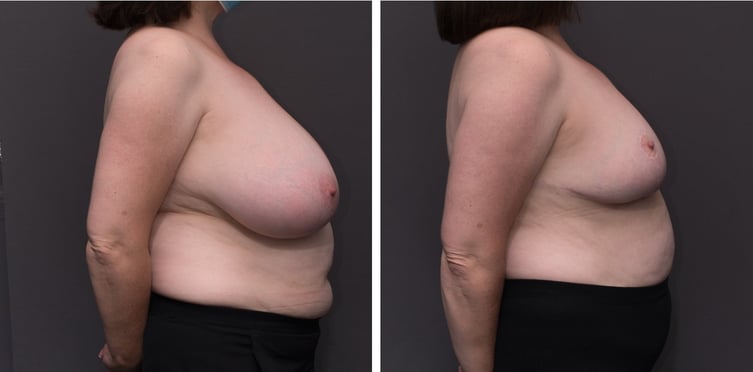Breast reduction surgery involves a combination of skin and breast tissue removal and reshaping. The surgery aims to reduce the size and weight of large breasts by lifting the breasts off the lower chest and upper abdomen. The objective is to leave the breasts smaller and lighter, sitting higher on the chest and closer to the body.
This 57-year-old woman was referred by her GP to Dr Avery to discuss her surgical options for addressing her large breasts, which were significantly impacting her upper back area.
After a collaborative consultation, Dr Avery was chosen to complete breast reduction surgery. The aim of breast reduction surgery is to reduce the heaviness of the breasts by removing skin and breast tissue and positioning the breast higher up on the chest wall. A breast reduction can involve reducing very heavy breasts (usually referred to as macromastia) or very long, elongated breasts, but usually they are a combination of both.
For this patient, Dr Avery was able to remove 1.25kg from the right breast and a further 1.28kg in her slightly larger left breast. Asymmetry in breast size is common and while more difficult to address in surgery it is possible. During the surgery the enlarged areola was also reduced and the nipple and areola were repositioned higher on the breasts, a lift of over 10cm on both breasts.
These clinical before and after photographs were taken 10 months following surgery, with the final scar maturation usually occurring 12-18 months following surgery.
Medicare recognise breast reduction surgery as a medically necessary surgery for the treatment of macromastia and allocate the item number 45523 to the procedure. This in turn means that health insurers will also contribute to the cost of this surgery which can bring enormous symptomatic relief for patients.
Patients considering any form of surgery will need to come in for a consultation with Dr Avery to discuss your expectations, along with the surgical options for how these can be achieved. During your consultation with the Avery team, we will ensure that the surgery you are considering is the appropriate choice for you.
At Avery, we welcome the opportunity to have an open conversation with you to understand the changes you are looking for with surgery. Our patients’ stories matter a great deal to us.
Wherever you are on your personal journey, we would like to assist you. Your reasons for having surgery and your expectations from surgery are important conversations to have before undergoing surgery. Dr Avery will also assess your health and medical history to ensure any surgical procedure you are considering is a safe and appropriate choice for you.
You can also see more before and after images, here. Dr Avery has extensive experience performing surgery and as we take our patients’ privacy very seriously, we do not display our full gallery online. All patients with photographs in the gallery have provided written consent.



These photos are of a real patient who has given their consent for their photos to be shown and depict surgeries performed by Dr. Gary Avery (MED0001633092) a registered medical practitioner, with specialist registration in Surgery – Plastic Surgery .
Please note that individual results will vary depending on the individual, their genetics and lifestyle factors, and all surgeries have associated risks. Before proceeding with any surgery, it is advisable to seek a second opinion from an appropriately qualified medical practitioner such as a Plastic Surgeon.
Plastic Surgeon is a regulated term that can only be used by surgeons who have completed specialty training within plastic surgery and are Fellows of the Royal Australasian College of Surgeons (FRACS). The specialty training undertaken by Plastic Surgeons includes the surgical skills required for excellence in aesthetic surgery.